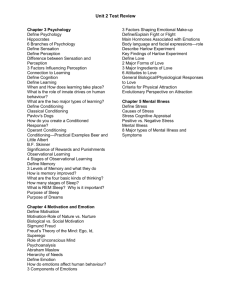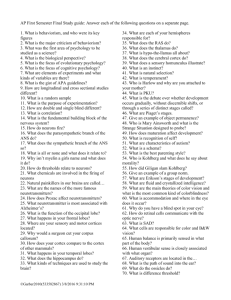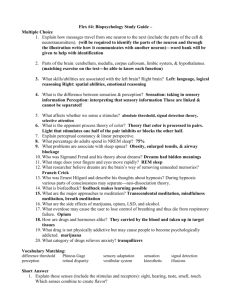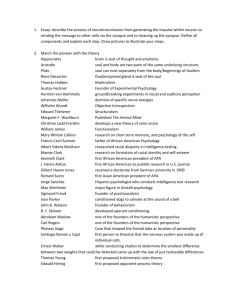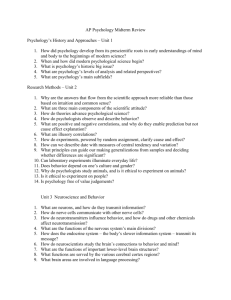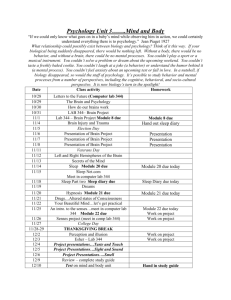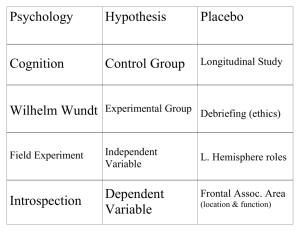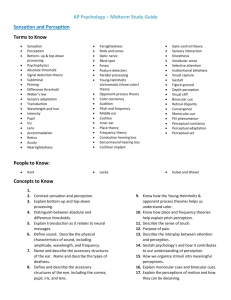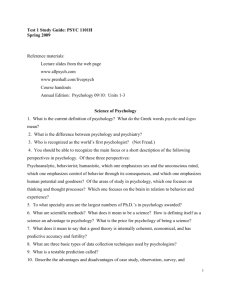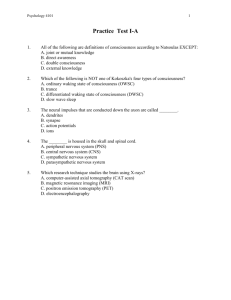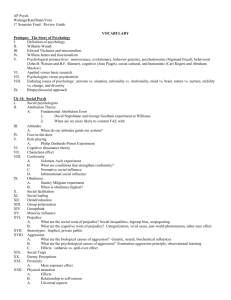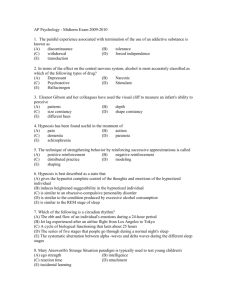Psy 201 general review
advertisement
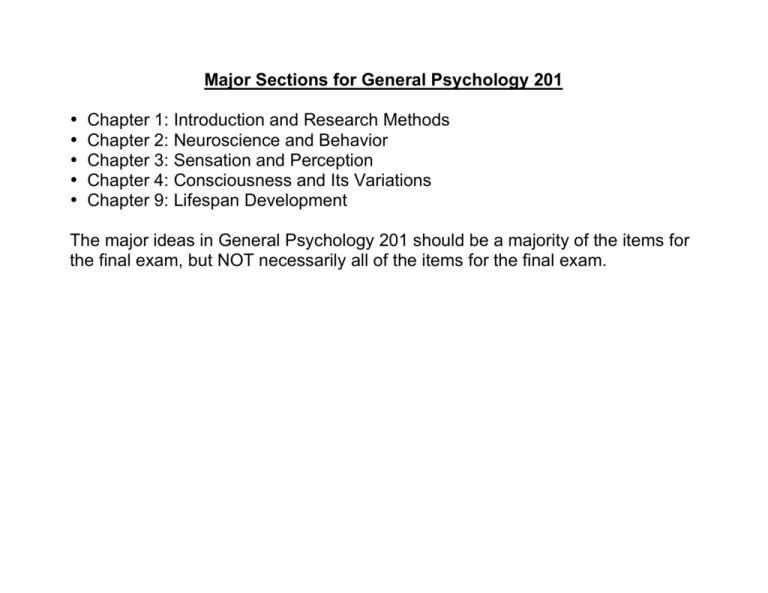
Major Sections for General Psychology 201 • • • • • Chapter 1: Introduction and Research Methods Chapter 2: Neuroscience and Behavior Chapter 3: Sensation and Perception Chapter 4: Consciousness and Its Variations Chapter 9: Lifespan Development The major ideas in General Psychology 201 should be a majority of the items for the final exam, but NOT necessarily all of the items for the final exam. Chapter 1: Introduction and Research Methods Background of Psychology and the People The Origins of Psychology • • • • • • • • Influence of Philosophy Influence of Physiology Wilhelm Wundt Edward Titchener (Structuralism) William James (Functionalism) Sigmund Freud (psychoanalysts) John Watson (Behaviorism) Carl Rogers (Humanism) Doing Research Contemporary Psychology • • Perspectives in Psychology (7) Specialty Areas in Psychology (10) The Scientific Method • • • 1. 2. 3. 4. • • • What is critical thinking? What is the scientific method Steps in the “scientific method” Formulate a testable hypothesis Design a study to collect data Analyze the data and interpret Report the findings Constructing a theory Evaluating mass media reports about psychology Problems with casually testing beliefs Descriptive Methods • • • • Naturalistic Observation Case study Surveys Correlational studies Experimental Methods “Do violent video games increase aggressive behavior”? • Hypothesis and random assignment • Experimental, control groups and independent variable • Dependent variable • Experimental procedure • Results and Discussion • Variations in experimental designs • Limits of experiments Ethics in Psychological Research Questions about the use of animals in psychological research Chapter 2: Neuroscience and Behavior The Neuron • • • • Structure of the Neuron Communication Between Neurons Neurotransmitters (6) How Drugs Influence Communication between Neurons (4) The Nervous System and Endocrine System • • • • • Central Nervous System (CNS) Peripheral Nervous System (PNS) Somatic Nervous System Autonomic Nervous System (Parasympathe tic and Sympathetic NS) Endocrine system The Brain Hindbrain • • • • Pons Reticular Formation Cerebellum Medulla Midbrain • Substantia Nigra Specializations of the Cerebral Hemispheres Forebrain • • • • • • • • Corpus Callosum Cerebral Cortex Frontal Lobes Parietal Lobe Temporal Lobe Occipital Lobe Broca’s Area Wernicke’s Area Limbic System • • • • Amygdala Hippocamp us Thalamus Hypothalam us • • • • Left Hemisphere and Language Cutting the Corpus Callosum Plasticity and the Brain (juggling) Pumping More Neurons into the Brain Chapter 3: Sensation and Perception Sensation Vision Hearing Principles of Sensation and Perception • Sensory Adaptation • • • • Structure of the Eye Rods and Cones Trichromatic Theory Opponent Process Theory • • • • • • Structure of the Ear How do we hear Place Theory Frequency Theory Conduction Deafness Nerve Deafness The Chemical and Body Senses • • • • • Smell Taste Touch Vestibular Kinesthetic Perception Depth Gestalt Laws Perceptual perception and Illusions and Cues Constancies Perceptual Sets Top-Down and Bottomup • • Examples of Top-Down processing Examples of Bottom-up processing • • Perception is a constructed Process-Context effects Monocular Depth Perception Cues (6) • • Gestalt Laws of Organizatio n (4) Constancies (2) • • • What do illusions tell us about Perception Perceptual Sets Strategies for Controlling Pain Chapter 4: Consciousness and Its Variations Biological and Environmental Clocks • • • • SCN Role of pineal gland and melatonin “Free-Running” Jet-Lag Sleep • • • • • How sleep changes during the night How sleep changes over the lifespan Restorative theory of Sleep Strategies for Improving Sleep Sleep Deprivation Dreams and Mental Activity During Sleep • • The Brain during sleep REM sleep and memory consolidation Hypnosis • • • Effects of Hypnosis Neo-Dissociation theory of hypnosis Social-Cognitive Theory of Hypnosis Meditation • Effects of Meditation Psychoactive Drugs • • • • • • Common properties of drugs Depressants Opiates Stimulates Psychedelics Ecstasy and Dissociative Anesthetic drugs Chapter 9: Development Across the Lifespan Genetics • • • • • DNA Genes Chromosomes XX versus XY Genotype and phenotype Prenatal Development • Teratogens Development During Infancy and Childhood • Cognitive Development (Piaget) Adolescence • • • Erikson’s psychosocial Crises (8) Moral Reasoning (Kolhberg and Gilligan) Late and early developers in puberty Adult Development • Late Adulthood and Aging • Activity Theory of aging Raising Psychologically Healthy Children • 4 parenting styles


